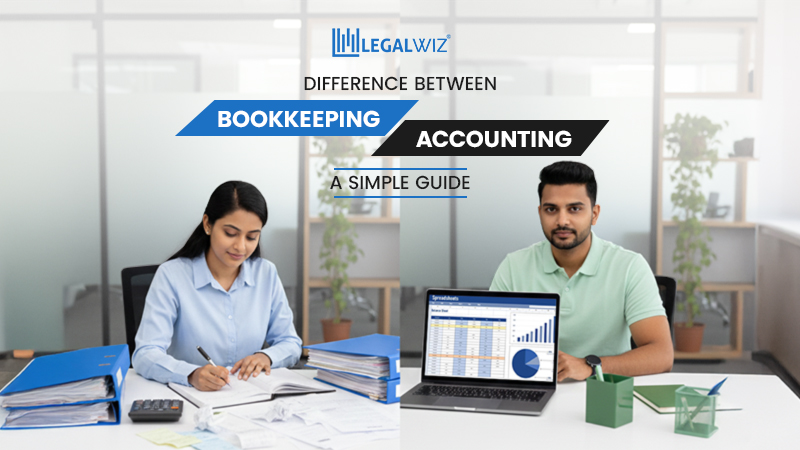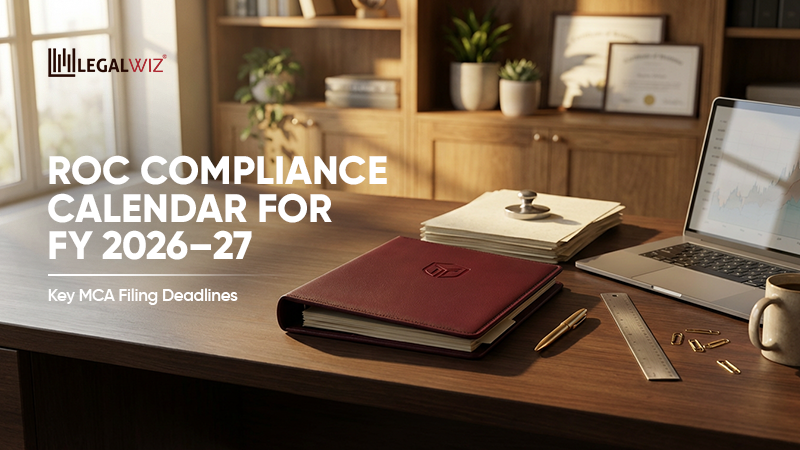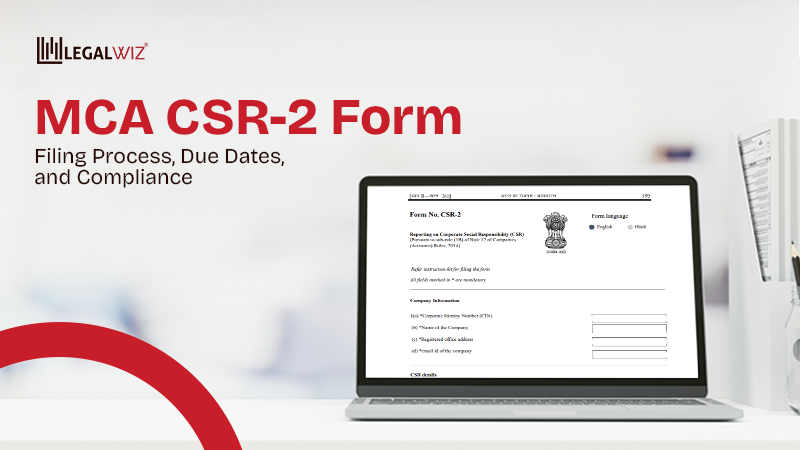Form AOC-4 Filing – Due Date, Fees & Compliance Guide [FY 2024-25]
🔔MCA Extends Annual Filing Deadlines to 31st December 2025 for Companies
For the financial year 2024–25, the Ministry of Corporate Affairs (MCA) has extended the due dates for filing Forms AOC-4, AOC-4 XBRL, and AOC-4 CFS (previously due on 29th October 2025) and Forms MGT-7 and MGT-7A (previously due on 29th November 2025) to 31st December 2025, without any additional fees.
A company’s accountability to its stakeholders is essential, and it is demonstrated through financial statements, disclosures, and the Board and Audit Reports, which together provide a clear view of the business.
To maintain this transparency, every company must file its financial information with the Ministry of Corporate Affairs (MCA) through Form AOC-4. For those who have recently registered their business, this annual compliance for your company is critical because it creates an official record of your company’s finances.
In this post, we’ll go over the whole process of filling out Form AOC-4 in great detail.
1. What is Form AOC-4?
Form AOC-4 is the official financial statement that your company submits to the Ministry of Corporate Affairs (MCA). It includes key financial details such as the Balance Sheet, Profit & Loss Account, and other relevant statements that reflect the company’s financial position and performance.
This filing is mandatory under the Companies Act, 2013, and helps the government maintain transparent records of every company’s financial activities.
Along with Form AOC-4, companies must attach certain supporting documents to complete the filing, such as:
- Board’s Report
- Auditor’s Report
- Statement of Subsidiaries (Form AOC-1)
- CSR Policy Details (if applicable)
All these documents must be certified by a practicing chartered accountant or Company Secretary to ensure compliance.
| Want to know what else to include in a company’s annual report? Explore our detailed blog here: Matter to be covered in the annual report of a Pvt Ltd and OPC |
In short, it’s mandatory, important, and honestly way less intimidating than it sounds, especially if you follow the steps correctly.
2. Who Needs to File AOC-4?
1. All Companies:
Every company registered under the Companies Act, 2013, must file its annual financial statements using Form AOC-4. This requirement applies whether or not the company carried out business activities during the financial year.
Here’s a quick breakdown of who needs to file:
- Private Limited Companies
- Public Limited Companies
- One Person Companies (OPCs)
- Section 8 Companies
- Companies with Subsidiaries
2. NBFCs under Ind AS:
Non-Banking Financial Companies (NBFCs) following Indian Accounting Standards (Ind AS) must file:
- Form AOC-4 NBFC (Ind AS) for standalone financials
- Form AOC-4 CFS NBFC (Ind AS) for consolidated financials (if applicable)
3. Companies with CSR Obligations:
Companies falling under Section 135(1) of the Companies Act, 2013 (CSR provisions) must submit:
- Form CSR-2 as an addendum to AOC-4, AOC-4 XBRL, or AOC-4 NBFC (Ind AS)
- For FY 2021–22, CSR-2 could be filed separately (deadline was 31st March 2023)
4. Companies Covered Under XBRL Rules:
These companies must file financials in AOC-4 XBRL format:
- Listed companies and their Indian subsidiaries
- Companies with paid-up capital ≥ ₹5 crore
- Companies with turnover ≥ ₹100 crore
- Companies preparing financials under Ind AS
Know more about filing based on your company’s turnover: Annual compliances for a private company based on turnover
3. Key Compliance Requirements for AOC-4
Filing Form AOC-4 for a company isn’t just about clicking “submit” online. There are a few essential boxes to tick to keep everything smooth, legal, and penalty-free:
1. Verification of DIN & DSC
Every director in your corporation needs a Director Identification Number (DIN) and a Digital Signature Certificate (DSC), your digital boarding pass to the MCA portal.
Pro Tip: Before you file, make sure both are active and linked.
| And to learn more about DIN, read our detailed blog here: What is a Director Identification Number (DIN)? How to apply for it? |
2. Auditor’s Report Preparation
- You need an auditor’s report (unless you’re exempt).
- This is your financial health check-up, making sure your numbers are clean and compliant.
3. Drafting of Board Report
- No matter what size your business is, the Board Report is still an essential aspect of this filing.
- It covers your performance, plans, and major decisions.
If you correctly complete these three steps, your AOC-4 filing will be simple and free of penalties.
4. Form AOC-4 Filing Deadline for FY 2024-25: Key Due Date Explained
Mark your calendars, company owners! Whether you run a Private/Public Limited Company or a One Person Company (OPC), filing your Form AOC-4 on time keeps your business compliant and penalty-free.
Note: The usual due date for filing AOC-4 (except for OPCs) is 29th October, within 30 days from the conclusion of the AGM. However, for FY 2024–25, the MCA has extended the due date for AOC-4 to 31st December 2025. This extension applies only to FY 2024–25.
Here’s a quick look at the due dates for FY 2024–25:
| Type of Company | Purpose of Form | Filing Frequency | Due Date (FY 2024–25) | Remarks |
| One Person Company (OPC) | Filing of financial statements | Yearly | 27th September 2025 | Within 180 days from the financial year-end (no AGM required) |
| Private Limited Company | Filing of financial statements | Yearly | 31st December 2025 | Within 30 days from the conclusion of AGM (if held on 30th September 2025) |
| Public Limited Company | Filing of financial statements | Yearly | 31st December 2025 | Same rule — 30 days from AGM |
| Section 8 Company | Filing of financial statements | Yearly | 31st December 2025 | AGM is generally held before 30th September |
| Company with Subsidiaries (AOC-4 CFS) | Filing of consolidated financial statements | Yearly | Same as AOC-4 (31st December 2025) | File both AOC-4 and AOC-4 CFS separately |
Pro tip: Set reminders early and file before the due date to avoid hefty penalties and unnecessary stress.
5. What Documents Are Required with Form AOC-4?
When filing Form AOC-4, the following documents must be attached:
- Balance Sheet along with notes
- Profit and Loss Statement with notes
- Cash Flow Statement
- Statement of Changes in Equity (if applicable)
- Auditor’s and Board’s Report
- Corporate Social Responsibility (CSR) Report, if applicable
- Authenticated copy of financial statements as per Section 134, including the Board’s report, auditors’ report, and other relevant documents
- Statement of subsidiaries in accordance with Section 129 – Form AOC-1
- Statement explaining the reasons for not adopting the financial statements at the Annual General Meeting (AGM)
- Statement explaining the reasons for not holding the AGM
- Approval letter for extension of the financial year or AGM
- Supplementary or test audit report under Section 143
- Company CSR policy as per sub-section (4) of Section 135
- Details of other entity/entities
- Key features and justification for entering into contracts, arrangements, or transactions with related parties as per sub-section (1) of Section 188 – Form AOC-2
- Comments from the Comptroller and Auditor General (CAG) of India
- Secretarial Audit Report
- Directors’ report as per sub-section (3) of Section 134
- Details of remaining CSR activities
- Any other relevant documents, as required
Note: For companies other than OPCs and small companies, the form must be certified by a practicing professional, either a Chartered Accountant (CA) or a Company Secretary (CS).
6. How to File Form AOC-4: Quick & Easy Steps
Filing Form AOC-4 might sound like a paperwork maze, but spoiler alert: it’s actually easy, especially when you know where to click and what to prepare.
Let’s break it down:
Step 1: Log In to the MCA Portal
Go to www.mca.gov.in, click on the ‘Login’ button, and enter your credentials. Don’t have an account? No worries—signing up is free and faster.
Step 2: Download the Right Form
Navigate to the MCA Forms section and get the Form AOC-4 that fits your company type: Standard, XBRL, or Ind AS (NBFC).
Step 3: Fill in the Company Details
Add all the important details, company information, financial data, auditor details, and more.
Pro tip: keep your documents nearby so you won’t have to look for your files at the last minute.
Step 4: Upload Mandatory Attachments
Time to upload the required documents: balance sheet, profit and loss (P&L) statement, board report, auditor’s report, etc. This is not the time for finding alternatives—missing attachments = instant rejection.
Step 5: Apply Digital Signature
Use a valid Digital Signature Certificate (DSC) of an authorized director or professional. No printing, no scanning, just click, sign, and you’re done.
If you don’t know how to register for DSC, we have created a comprehensive guide for you. Read the full blog here: DSC: All about Digital Signature Certificates
Step 6: Submit and Pay
Upload your filled form, pay the filing fee online, and boom, you’re done! Watch out for any errors or confirmations, and save your acknowledgment.
Follow these steps, and filing AOC-4 won’t just be easy; it’ll feel like you just beat the final boss of financial compliance.
7. Filing Fees for Form AOC-4 (Based on Share Capital):
| Nominal Share Capital | Fee Applicable |
| Less than ₹1,00,000 | ₹200 per document |
| ₹1,00,000 to ₹4,99,999 | ₹300 per document |
| ₹5,00,000 to ₹24,99,999 | ₹400 per document |
| ₹25,00,000 to ₹99,99,999 | ₹500 per document |
| ₹1,00,00,000 or more | ₹600 per document |
| The company does not have share capital | ₹200 per document |
8. Late Fees & Penalties for Form AOC-4
1. Late Fees
If there’s a delay in filing your annual returns, balance sheet, or financial statements, the following late fee applies:
| Period of Delay | Additional Fee Payable |
| Delay beyond the due date under Section 137(1) (i.e., filing beyond 30 days of the AGM) | ₹100 per day |
2. Penalties for Non-Filing
Failing to file Form AOC-4 on time can attract penalties for both the company and its directors:
| Defaulting Party | Penalty Imposed |
| Company | ₹10,000 in case of continuing failure + ₹100 per day, max ₹2,00,000 |
| Directors 1. Managing Director/CFO 2. Any director assigned by the Board 3. All directors, if no one else | ₹10,000 + ₹100 per day, max ₹50,000 |
Pro Tip: Late filing increases your costs and reflects poorly on your compliance record. File on time and avoid these extra charges!
Final Takeaway: Don’t Sleep on AOC-4 – Your Company Depends on It
Filing Form AOC-4 isn’t optional; it’s the law. Even if your company didn’t do much this year, annual reporting is still mandatory.
If you miss the deadline, you will face:
- ₹100/day in fines (yes, every single day)
- Director disqualification
- Experiencing difficulties with audits, securing funding, or transitioning your company in the future.
So why do so many businesses wait until the last minute? Usually, it’s confusion, portal issues, or simply not knowing where to start. That’s exactly why Legalwiz.in exists. We make AOC-4 filing easy, fast, and 100% compliant.
Deadline: For Public/Private Companies – 31st December 2025 and for OPC – 27th September 2025. File early, skip the penalties, and relax.
Let Legalwiz.in handle it end-to-end. Get expert help and save on professional fees when you connect with us today.
Frequently Asked Questions
What is Form AOC-4, and why do I need to file it?
Form AOC-4 is the annual financial statement filing required for all companies under the MCA. It ensures compliance with the Companies Act and helps avoid penalties for non-filing.
Which companies are required to file Form AOC-4?
Every company registered under the Companies Act, including One Person Companies (OPCs), NBFCs under Ind AS, and companies with CSR obligations, must file it.
What is the deadline for filing Form AOC-4 for FY 2024-25?
You must file Form AOC-4 by 31st December 2025, and for all OPCs, the last date is within 180 days of your financial year-end, which is 27th September 2025 for FY 2024-25.
What documents need to be submitted along with Form AOC-4?
You’ll need to submit your balance sheet, profit & loss statement, auditor’s report, board report, and other related financial documents.
What are the penalties for late filing of Form AOC-4?
Late filing attracts a penalty of an additional ₹100 per day with no maximum cap, along with potential director disqualification and audit issues.

Sapna Mane
Sapna Mane is a skilled content writer at LegalWiz.in with years of cross-industry experience and a flair for turning legal, tax, and compliance chaos into clear, scroll-stopping content. She makes sense of India’s ever-changing rules—so you don’t have to Google everything twice.
![Form AOC – 4 Filing Form AOC-4 Filing – Due Date, Fees & Compliance Guide [FY 2024-25]](https://www.legalwiz.in/wp-content/uploads/Form-AOC-4-Filing-1.jpg)






